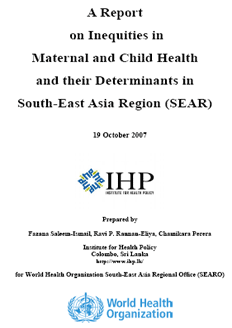Project report describing the results of the IHP anaysis of social disparities in MNCH outcomes in several WHO SEAR regional countries, and and the analysis of their determinants.
Abstract
There are significant social disparities in health in WHO South-East Asian Region (SEAR) countries. The WHO Commission on Social Determinants of Health called on countries to monitor these discrepancies on a routine basis, and to formulate policies to address them. This analysis examines disparities in maternal, child and nutritional indicators in several regional countries, comprising Bangladesh, India, Indonesia, Nepal and Sri Lanka, and explores the determinants of the disparities in child stunting and skilled birth attendance. it finds that education and other social factors play major roles, and the role of the health system as a determinant is greater for skilled birth attendance, as well as varying in impact across countries.
Content
1. Introduction
1.1. Health inequities, health policy and development
1.2 Measurement of health inequities
1.3 Determinants of health inequities
- CSDH Framework used for Analysis
- Data
2. Health inequities: magnitude and trends
2.1 Introduction
2.2. Inequities in health systems variables within and across countries in SEAR
- Coverage of DPT3 vaccination
- Coverage of skilled birth attendance
- Use of modern contraception
2.3. Inequities in health outcomes within and across countries in SEAR
- Infant mortality
- Under-five mortality
- Prevalence of stunting in children under five
- Prevalence of underweight women
- Prevalence of overweight women
2.4 Inequities in key health determinants within and across countries in SEAR
2.4.1. Exposure to safe water
2.4.2. Exposure to safe sanitation
3. Identifying determinants of health inequities
3.1 Main contributors to inequities in skilled birth attendance
3.2 Main contributors to inequities in childhood stunting
4. Conclusions and implications
4.1 Discussion of main findings from the analysis
4.2 Policy Implications

